ISSN ONLINE(2319-8753)PRINT(2347-6710)
ISSN ONLINE(2319-8753)PRINT(2347-6710)
Dhavalkumar Patel 1, Dr. Bhavesh Patel 2
|
| Related article at Pubmed, Scholar Google |
Visit for more related articles at International Journal of Innovative Research in Science, Engineering and Technology
Due to the rising need for the resources of energy especially in the developing countries, solar energy is gaining importance. This paper presents the extremely low cost and robust dual axis tracking system that positions solar panel to receive maximum solar energy. Rotation around one axis is automatic and done daily to track the sun while second axis is used for manual adjustment against seasonal variation in the sun path. Database for position of the sun at any point of time from any location on earth is available online. The unique feature of the system is it uses optimized database of yearly sun position for particular location on earth to track the sun, which enables the system to work even in the cloudy weather. Light detector sensors are not used otherwise requires cleaning of the sensors as well as malfunction in cloudy weather which is eliminated. Low cost close loop control system is used to position the solar panels.
Keywords |
| Azimuth angle, Elevation angle, Solar tracking, Close loop control. |
INTRODUCTION |
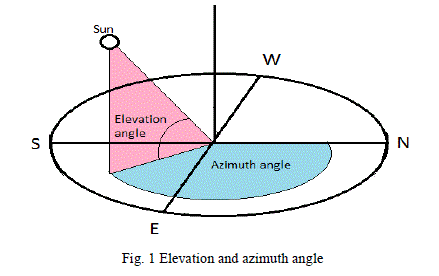 |
| A solar tracking is to orients photovoltaic panels to minimize the angle of incidence between the incoming sunlight and a photovoltaic panel [1]. The angle about the vertical axis is called the azimuth angle and is 0 at due North and becomes positive as you start to point East. The angle about the horizontal axis is called the elevation and is 0 level to the horizon and becomes positive towards the sky as per indicated in the fig.1 [2]. There are various types of solar tracking configurations like single axis on the horizontal axis, single axis on vertical axis, single axis on tilted axis and automatic dual axis [3]. But we have implemented dual axis tracker in which rotation around one axis is automatic whereas tilting adjustment is manual. |
DATA OF SUN POSITION |
| Experimental work was carried out on the location mentioned in the Fig.2 and data plotted in Matlab was collected from online sun-earth tool [4]. If we correlate the Fig.1 and Fig.2, it could be inferred that maximum value of elevation angle varies around 46. 88 ° yearly from 42.97 ° minimum during the winter up to 89.85 ° maximum during the summer. Variation in the elevation angle was considered for the manual seasonal adjustments design. |
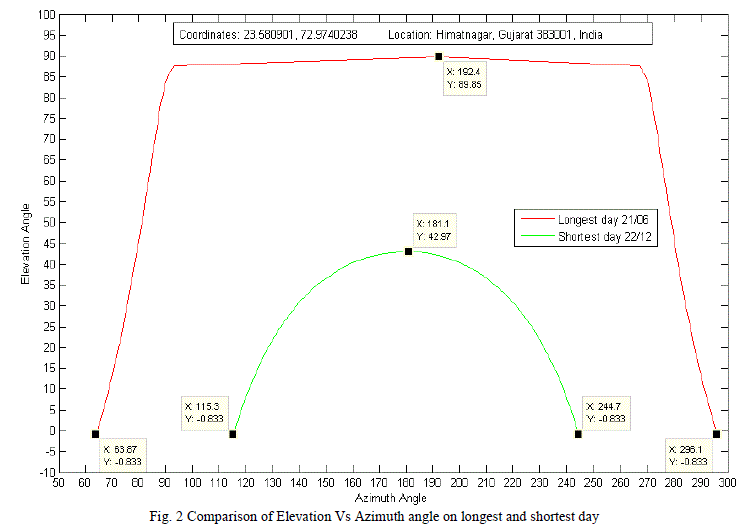 |
| Furthermore, variation in the azimuth angle during the winter season which is 115.3° SE to 244.7° SW is very less compare to summer which is 63.87° NE to 296.1° NW. The mechanism for tracking has been designed based on above inference. It is evident that elevation angle is more than 45° for most of the time of the year. The effectiveness of tracking would be more if axis of rotation is kept according to shown in Fig.3 below. |
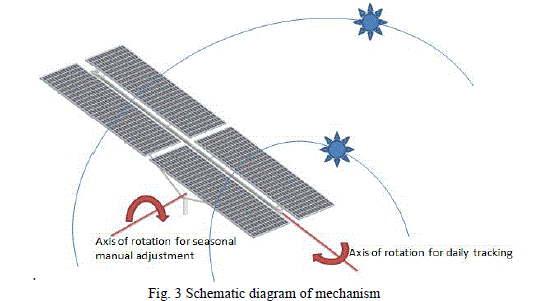 |
| Additionally, from data plotted in Matlab as in Fig.4, it could be inferred that variation in elevation angle on particular day is more linear during the summer and become nonlinear towards the winter season. |
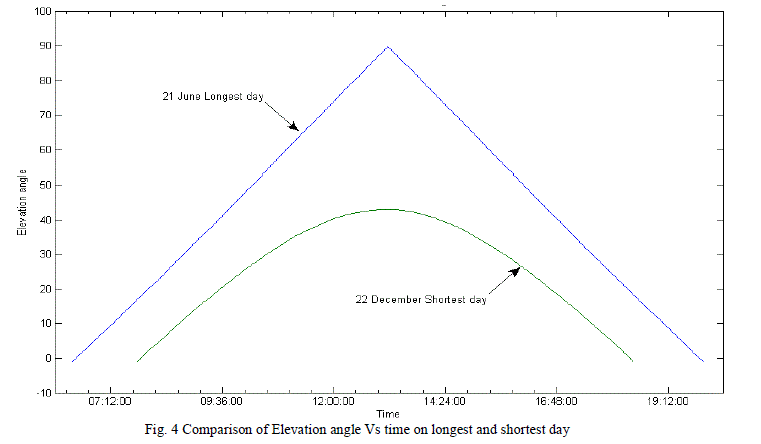 |
| On the other hand, variation in azimuth angle on particular day in winter are more linear compare to a day in summer as shown in Fig. 5. In addition to that, difference in the total variation in maximum elevation angle is around 45° where as it is around 103° for azimuth angle. |
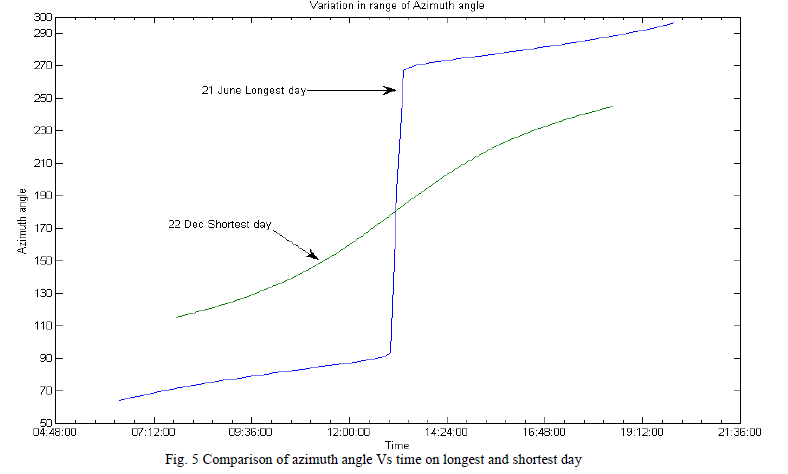 |
| Here in our system, tracking follows the variation in elevation angle with the rate and time at which elevation angle starts to increase from 0° to its maximum value on particular day , but panels are rotated from sunrise to sunset (total rotation) during both summer and winter depending on azimuth angle. |
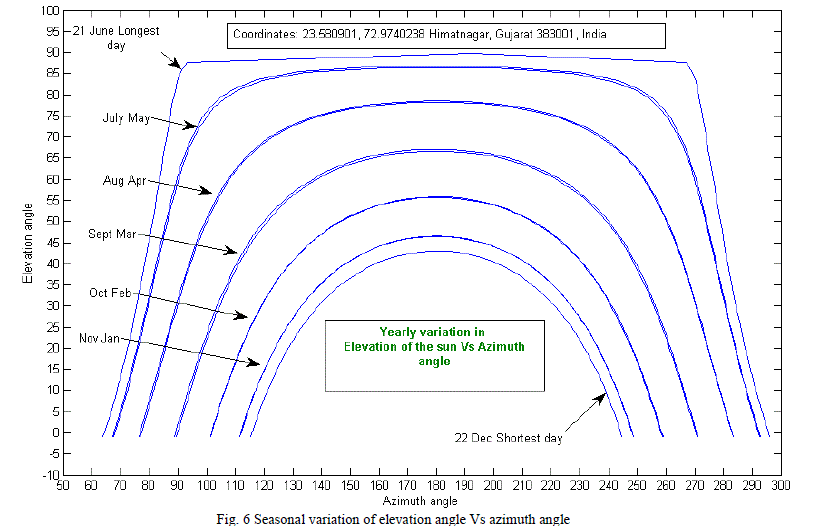 |
| It is difficult to store the data of variation in azimuth and elevation angle with time stamp (at 5 minutes interval) for each day of the year on the given location. However it could be inferred from Fig.6 that we need to consider the data of half year only, for remaining half year it remains almost same. Moreover, the data is mirror about the midday as observed from Fig.4 and Fig.5. In addition to this, it is easy to store data in the form of equation rather than storing the discrete data, mathematical functions has been developed from curve fitting of data of each day and was verified in Matlab and then program was prepared accordingly [5]. |
SYSTEM ARCHITECTURE AND WORKING |
| The tracking system is depicted in the Fig. 7. Motor is controlled by PWM IGBT based motor driver [6]. Microcontroller generates the control signals according to the program. Battery (12 V 36 AH) is used so that panels can be oriented back to the East position after sunset for the next day tracking. Rotary potentiometer (270° Precision) has been attached to get the feedback of actual angle. LCD normally displays date and time. Push buttons are provided to check other status of the system along with to adjust the date and time. Inverter and charge controller were purchased as per our configuration. Tracking is done once elevation angle is more than 5° after sun rises. |
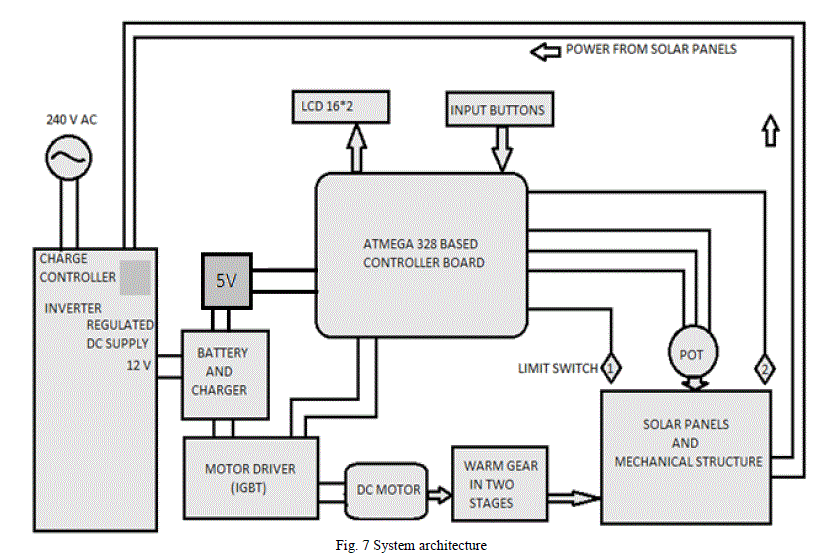 |
| The panels (250W each total 1000W) as sown in Fig.8 mounted on the frames are rotated by DC motor through warm gearbox There are two limit switches placed at both end for protection of the panels against malfunction of the system as shown in Fig.8. |
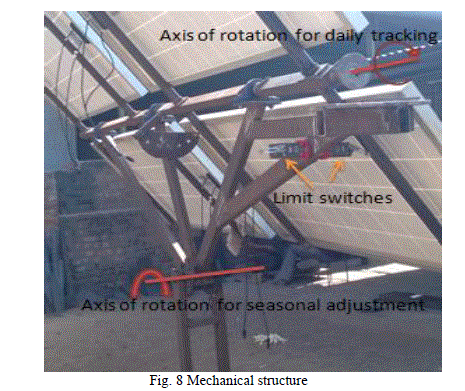 |
| EXPERIMENTAL RESULTS |
| Experimental set up is as shown in Fig. 9. Whole structure is mounted on the pole on terrace. Data was collected directly on laptop through serial communication with microcontroller and was compared with the desired positions. |
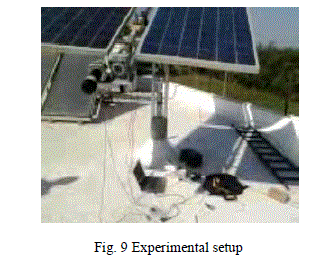 |
| The experimental results of the date 21/03/2014 has been shown in Table below when sun rises exactly in the due east and sets in due west. The other experimental results has been collected at 10 minutes on each 7th day and has shown good tracking results till date. The average difference in original solar vector (using azimuth and elevation angle) and our system vector varies by 2 - 6%. |
 |
CONCLUSION |
| The developed and implemented design is very low cost, user-friendly, accurate and robust single axis solar tracking system using mathematical equations derived from location based data to increase the efficiency of solar power systems. Above system demonstrates that the proposed technology is feasible for use in a wide range of applications that require solar tracking such as parabolic trough collector, solar dish, lens and other PV systems. |
References |
|